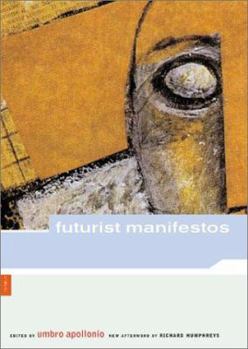Book Overview
On February 20th, 1909, a belligerent manifesto announcing the birth of the Futurist movement appeared on the front page of the Paris newspaper Le Figaro and sent immediate shockwaves throughout... This description may be from another edition of this product.
Format:Paperback
Language:English
ISBN:0878466274
ISBN13:9780878466276
Release Date:October 2001
Publisher:MFA Publications
Length:240 Pages
Weight:0.80 lbs.
Dimensions:0.7" x 5.8" x 8.3"
Customer Reviews
1 rating
Major Collection of Avant-Garde Manifestos on Visual and Language Arts
Published by Thriftbooks.com User , 16 years ago
_Futurist Manifestos_ is an extremely important and useful book, a must for anyone interested in early-twentieth-century avant-garde. In Italian Futurism, theory and practice went hand-in-hand rather like they once did in physics, with the artists considering their, say, painting as an experimental ground for testing and developing their theories not just about painting, but about the world. Understanding the ontologies and desires of the movement completely changes the way you look at Futurist art, gives you the keys to it, as it were. Actually, it changes the way you look at all of early-twentieth-century avant-garde practice, the whole fifth floor of the MoMA. It's not the first book on Futurism that I read, but it certainly packs the most punch, despite the fact that some of the artists' prose can frustrate, bore, etc.; and it takes an effort to grasp what they're talking about. And what they're talking about is the nature of reality. The reality that the Futurists want to portray is not the visual reality that is usually incriminated by the term "realism," but reality that is a) scientific and b) phenomenological. Thus, for example, instead of regarding painting as a representation of a three-dimensional world on a two-dimensional surface, Futurist painting wishes to express all dimensions--sounds, smell, brightness, etc. Instead of representing a moment of the world flux or, as they say, universal dynamism, they wish to express "the dynamic sensation itself"--basically, the world flux as it appears in the mind--and world objects as subjects of motion. "A horse in movement," writes Boccioni, "is not a motionless horse which is moving, but a horse in movement, which makes it another sort of thing altogether." Since Futurists deny absolute rest, this means that, as Severini notes, "individual objects do not exist anymore." Objects in Futurist paintings are deformed by speed; broken into planes by perception; interpenetrating with respect each other; superimposed by their environment (ie other objects and sensations). The influence of the discovery of X-rays is enthusiastically admitted by the Futurists themselves; also clear are representations of the Doppler effect; one wonders about relativity, but it seems as if artists didn't catch on to relativity until the end of WWI. Superheavy is the influence of Bergson, especially in Boccioni. Boccioni's distinction between absolute and relative movement, the role he allots to intuition as an epistemological tool that entails identification with object of knowledge, etc., position him as a very intelligent interpreter of the French philosopher. In paintings such as the Soccer Player (in the MoMA) Boccioni seeks to synthesize--by intuition--the absolute and relative motion of an object into a single intuited visual formula providing the continuity of the object in space. Balla, on the other hand, prefers analytic solutions to synthetic ones, and therefore represents the one moving object as a multi




